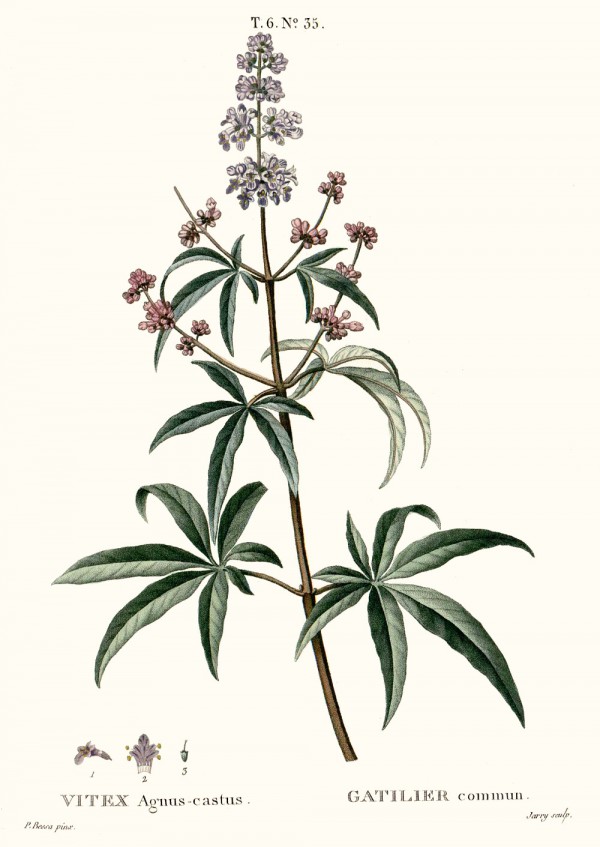Vitex agnus-castus L. - Verbenaceae - chaste tree, (Echter) Mönchspfeffer, Keuschlamm-Strauch
Shrub or small tree, up to 4m high, native from the Mediterranean region to Central Asia, naturalized elsewhere; leaves palmate, 5-7-foliolate; dense inflorescences of lilac to blue-violet flowers.
„In ancient times it was believed to be an anaphrodisiac, hence the name chaste tree. Pliny, in his Historia Naturalis, reports the use of stems and leaves of this plant by women as bedding „to cool the heat of lust“ during the time of the Thesmophoria, when Athenian women left their husbands' beds to remain ritually chaste.“
http://en.wikipedia.org/wiki/Vitex_agnus-castus
„Aromatic, but weak aroma; slightly pungent and bitter taste… Dried chaste tree berries have been used, in small scale, as a pepper substitute, but the taste is really rather weak.“ http://gernot-katzers-spice-pages.com/engl/Vite_agn.html
Hydrodistillation of ripe fruits gave essential oils with the main components sabinene (16.4-44.1%), 1,8-cineole (8.4-15.2%), β-caryophyllene (2.1-5.0%), and (E)-β-farnesene (5.0-11.7%).
[Parameters influencing the yield and composition of the essential oil from Cretan Vitex agnus-castus fruits., Sørensen, J.M., Katsiotis, S.T., Planta medica, 66(3), 2000, 245-250]
Main components of commercial Vitex agnus castus oils, steam-distilled from leaves and berries (Croatia), were sabinene (17.9-32.5%), 1,8-cineole (18.3-24.0%), α-pinene (2.7-8.8%), β-pinene (1.0-5.1%), limonene (1.5-8.4%), terpinen-4-ol (1.9-5.2%), α-terpinyl acetate (0.2-5.5%), and (E)-β-farnesene (3.1-4.0%).
[Nature's Gift GC analysis, 2014-2016] https://www.naturesgift.com/product/vitex-leaf-berry-2ml/
„Extracts of the fruits of chaste tree (Vitex agnus castus = AC) are widely used to treat premenstrual symptoms. Double-blind placebo-controlled studies indicate that one of the most common premenstrual symptoms, i.e. premenstrual mastodynia (mastalgia) is beneficially influenced by an AC extract…
Since AC extracts were shown to have beneficial effects on premenstrual mastodynia serum prolactin levels in such patients were also studied in one double-blind, placebo-controlled clinical study. Serum prolactin levels were indeed reduced in the patients treated with the extract. The search for the prolactin-suppressive principle(s) yielded a number of compounds with dopaminergic properties: they bound to recombinant DA2-receptor protein and suppressed prolactin release from cultivated lactotrophs as well as in animal experiments. The search for the chemical identity of the dopaminergic compounds resulted in isolation of a number of diterpenes of which some clerodadienols were most important for the prolactin-suppressive effects. They were almost identical in their prolactin-suppressive properties than dopamine itself. Hence, it is concluded that dopaminergic compounds present in Vitex agnus castus are clinically the important compounds which improve premenstrual mastodynia and possibly also other symptoms of the premenstrual syndrome.“
[Chaste tree (Vitex agnus-castus)–pharmacology and clinical indications., Wuttke, W., Jarry, H., Christoffel, V., Spengler, B., Seidlova-Wuttke, D., Phytomedicine, Vol.10(4), 2003, 348-357]
http://www.comilac.com.tr/uploads/pdf/25ComFUGA.pdf

Duhamel du Monceau,H.L., Traité des arbres et arbustes, Nouvelle édition [Nouveau Duhamel], vol.6 t.35 (1815) [P.Bessa]
http://plantgenera.org/species.php?id_species=1067002
Vitex agnus-castus; author: Rolf Marschner (2008),
www.botanische-spaziergaenge.at